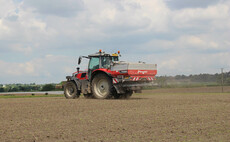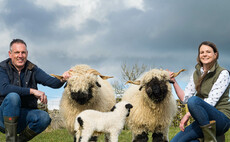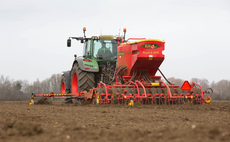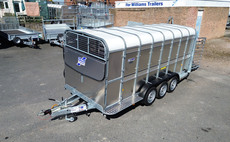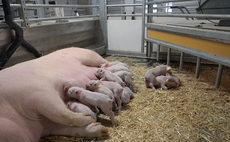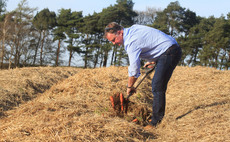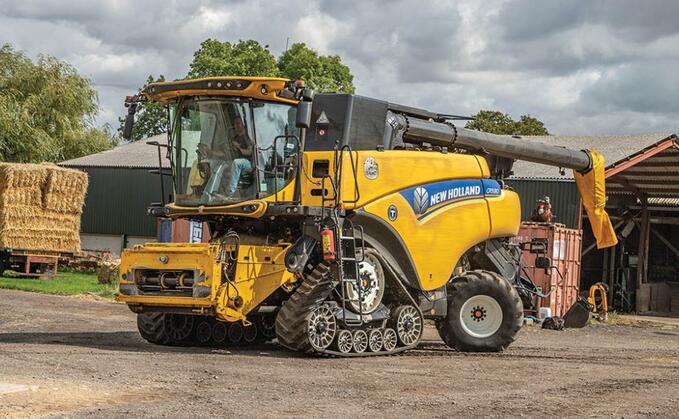
Opting for tracks on a combine will add a hefty price tag over wheels and tyres, but for one Oxfordshire grower, the decision to replace wide boots with long belts was worth it.
Geoff Ashcroft finds out why...
Without the simplicity of ring-fenced land around Clattercote Priory Farm, Claydon, near Banbury, A and J Taylor has to make use of local roads to access the 750 hectares it harvests each year.
Logistically, field locations have posed many challenges for the farm when it comes to moving machinery between blocks of land.
Adrian Taylor explains: We can move machinery up to 10 miles from our base at Clattercote Priory Farm.
Along with foreman Matt Bowen, he has made a point of moving its largest machine, a New Holland CR9.80 combine, veryearly in the morning.
Mr Taylor says: It is a time of day when we can have the least impact and also suffer the least intrusion from other road users. Travelling between the areas we farm can be a hassle with big kit if you do not plan properly.
Narrower
For the last two seasons, that impact has eased considerably since the farm took delivery of a New Holland CR9.80 combine shod on 600mm tracks, as Matt Bowen explains.
The newer combine is so much narrower than its predecessor, that it is now much easier to thread along local roads, he says.
And with Terraglide suspension, it is also a much more comfortable ride. It will run at 30kph all day on the road and not have you bouncing out of the seat should you find a pothole or verge.
Prior to the tracked CR arriving at Clattercote, the farm relied on a 2010 model CR9080 shod on 900mm-wide tyres, and equipped with a slightly smaller 9.1m header.
The CR9080 was a good machine, but it was such a pain to move around the roads, Mr Bowen adds.
We did look at a set of 1050s for it, to make the most of low ground pressure, but they were just too wide and too clumsy for our situation.
We also have a bridge to negotiate and that also dictated a maximum overall width for our combine.
The CR9.80 arrived for the start of the 2017 harvest as an ex-demo machine from local dealer PA Turney. It was already equipped with New Hollands SmarTrax system with suspension, and the deal provided an affordable route into more performance, productivity and comfort, compared to buying new.
Choosing SmarTrax alone is a 30,000 option and the Terraglide suspension can push the cost up by a further 10,000. Once you reach beyond a 9.1m header, rubber tracks are increasingly the only
viable choice for combines.
With 208ha at Clattercote Priory Farm, all remaining land is scattered north and south of Banbury and its surrounding villages. Though the rotation affords outlying land to be cropped in 40 hectare blocks.
Fortunately, output of the CR9.80 has also been improved over its predecessor.
We can now comfortably cut 100 acres per day, and our best day has seen 137 acres go under the knife with the CR9.80, says Mr Bowen. The best we could ever see through the CR9080 was 90 acres in a day and the planets had to align to achieve that output.
Importantly, the extra capacity makes it easy to move the combine before breakfast, then grease up and service in-field, ahead of a good days cutting.
With Varifeed on the combine header, Mr Bowen says the knifes location is rarely in its fully retracted position, and is managed in every crop to make the most of crop flow.
I aim to get the crop in heads-first, he adds. This is when output rockets. It makes the combine much easier to use, it helps to deliver a great sample, and with yield mapping too, I know exactly what is going on in every field.
With a focus on min-till, the farm was keen to see more consistent stubble heights, and to ensure a better chop and spread function across the wider working width.
Neither have been areas for concern, and with soil structure becoming an increasingly important aspect of crop production, the farm keeps tractors and trailers on grass margins around the outside of each field, with the combine travelling to the trailers to unload.
Where we do not have any grass margins, trailers have to sit in gateways, says Mr Bowen. We have spent the last six years pursuing min-till and strip-till systems, and we have recently switched from Mzuri to Claydon for our crop establishment, and our soils continue to improve.
With a Vaderstad Carrier 650 and a straw rake to generate a green bridge, the farm is managing black grass with the help of a six-year rotation and the inclusion of pig slurry form its own livestock enterprise.
Worm counts have gone from just two or three in a spade full of soil, to 30-40 worms per spade full, adds Mr Bowen.
The top layer is improving, yields are stable and establishment costs are under control. We see keeping traffic off the field as a vital part of maintaining that strategy.
So given the stability and capability of the CR9.80, would the farm consider going wider?
If we ever did, I would like to look at a MacDon header next time, says Mr Bowen. The rigidity of our 35ft header does mean there are a few places across the farm where stubble heights are shaved at one end and lengthy at the other.
Having a lighter, more flexible header that can follow ground contours across its cutting width would probably make a wider cut much more acceptable in our field conditions.
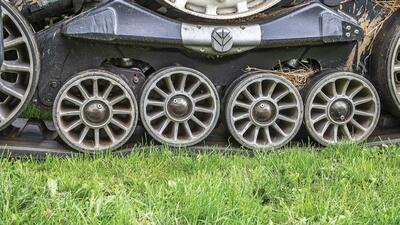
Verdict
Although tracks are specified on combines primarily for their low ground pressure and smooth riding characteristics, a significant reduction on overall width makes it much more convenient and less intrusive to move a combine between fields on the road.















